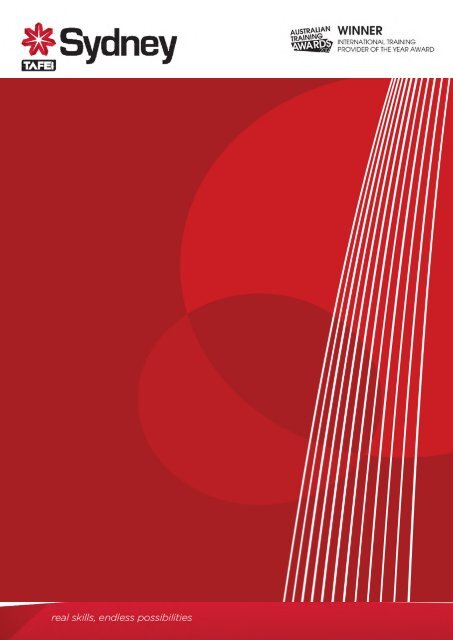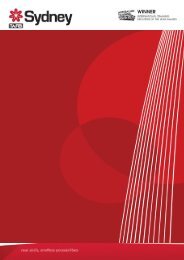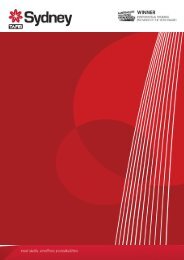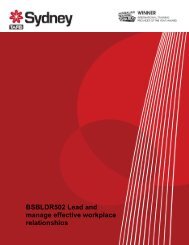Sustainability501 Session 4 Ver 1.0.1
- No tags were found...
Create successful ePaper yourself
Turn your PDF publications into a flip-book with our unique Google optimized e-Paper software.
`<br />
BSBSUS501 Develop workplace policy and<br />
procedures for sustainability<br />
Table of Contents<br />
6. Review sustainability policy implementation ............................................... 3<br />
6.1 Document outcomes and provide feedback to key personnel and<br />
stakeholders ....................................................................................................... 3<br />
6.2 Investigate successes or otherwise of policy ................................................ 6<br />
6.3 Monitor records to identify trends that may require remedial action and<br />
use to promote continuous improvement of performance ................................ 9<br />
6.4 Modify policy and or procedures as required to ensure improvements<br />
are made .......................................................................................................... 11<br />
APPENDIX 2 | REFERENCE LIST .................................................................................. 13<br />
BSBSUS501 Readings <strong>Session</strong> 4 <strong>Ver</strong> <strong>1.0.1</strong> Updated 10.2016 Page 1 of 17
`<br />
BSBSUS501 Develop workplace policy and<br />
procedures for sustainability<br />
Welcome<br />
This resource will help you to investigate key elements of sustainability policy<br />
development, including developing the policy scope and statement, consultation, and<br />
addressing any environmental compliance issues for your workplace. You’ll also plan<br />
and develop workplace procedures and activities in order to implement and<br />
communicate the policy. This will lead to having a system in place to continually<br />
improve and review workplace sustainability practices.<br />
BSBSUS501 Readings <strong>Session</strong> 4 <strong>Ver</strong> <strong>1.0.1</strong> Updated 10.2016 Page 2 of 17
`<br />
BSBSUS501 Develop workplace policy and<br />
procedures for sustainability<br />
6. Review sustainability policy<br />
implementation<br />
As part of continuous improvement activities you’ll need to investigate the success of<br />
your workplace sustainability policy including the procedures, and other implementation<br />
and communication activities that are part of the larger system. In this topic you will also<br />
investigate the reporting of outcomes as a result of the sustainability policy<br />
implementation. These activities will help you to identify improvements that need to be<br />
made to any part of the system.<br />
6.1 Document outcomes and provide feedback to key<br />
personnel and stakeholders<br />
It is most important for organisations to be transparent with plans and policies so<br />
that stakeholders can access all the information that they may need. If it is not easy<br />
to find, the stakeholders may question the organisation’s commitment to change. It<br />
is through communication that all outcomes, good and bad, can be seen by<br />
stakeholders. If the reports are positive the staff and stakeholders will<br />
be encouraged, if the result is negative, it will allow stakeholders and staff to<br />
investigate and fix the problem.<br />
BSBSUS501 Readings <strong>Session</strong> 4 <strong>Ver</strong> <strong>1.0.1</strong> Updated 10.2016 Page 3 of 17
`<br />
BSBSUS501 Develop workplace policy and<br />
procedures for sustainability<br />
Reports<br />
Compliance reports – Organisations are required to comply with various<br />
legislations, and to meet these regulations they will need to report to the<br />
regulators to demonstrate that they comply with the regulations.<br />
Quarterly target efficiency reports – These reports should compare corporate<br />
targets against actual achievements to date. These reports give stakeholders a<br />
reference point as to how the organisation is progressing and if targets are being<br />
met.<br />
These reports track the performance of:<br />
• the organisation as a whole<br />
• individual departments<br />
• individual teams within the various departments.<br />
If used as a continuous improvement tool, information from successful<br />
departments or teams can be shared.<br />
Look at the following table:<br />
Targetadmin<br />
Progress June 2016 Progress September 2016<br />
Company Department Team Company Department Team<br />
15%<br />
reduction<br />
in waste<br />
paper by<br />
1% 2% 5% 2% 4% 7%<br />
This table is easy to follow and shows us that we are on track to reduce our<br />
paper waste by 15% by 2016.<br />
This type of report shows that continuous improvement does work. If the result had<br />
been negative, we would then be able to address options for improvement and make<br />
changes to the policy in order to correct the bad outcome.<br />
Compliance review report – This report is used to check that any corrective action<br />
taken, has been positive and the result is that the target is now on track.<br />
BSBSUS501 Readings <strong>Session</strong> 4 <strong>Ver</strong> <strong>1.0.1</strong> Updated 10.2016 Page 4 of 17
`<br />
BSBSUS501 Develop workplace policy and<br />
procedures for sustainability<br />
Annual reports – Use TBL (Triple Bottom Line) reporting to report on environmental<br />
performance as well as financial and social reports. This is when an organisation can<br />
report on any environmental incidents that took place through the past year.<br />
Board reports – Ultimately, the board is responsible for legal compliance with<br />
regulations. It is therefore mandatory that the board is notified on a regular basis on<br />
the status of compliance. If a breach in compliance occurs, an extra-ordinary meeting<br />
should be held.<br />
International Best Practice reporting systems – ISO14000 AND Global Reporting<br />
Initiative have set criteria on sustainable reporting that are internationally recognised.<br />
These reports show the stakeholders that the organisation is complying with<br />
international standards of reporting.<br />
Activity 10<br />
Download the Lets Report it Template from the global Reporting Initiative website<br />
https://sielearning.tafensw.edu.au/moodle/mod/resource/view.php?id=429502<br />
Complete the report with reference to your chosen organisation.<br />
Discuss the following:<br />
• Any issues with using the report<br />
• Positive outcomes from the use of the report<br />
• Suitability of using this in your own workplace<br />
Newsletters – Types of newsletter could include:<br />
• Company newsletter for external distribution<br />
• Sustainability news letter<br />
• Internal company news letter<br />
These provide stakeholders with information on the progress of the organisation.<br />
They can include hints on how to improve resource usage in everyday practices.<br />
Company website – It is a useful tool to have a page on both the external and<br />
internal web page dedicated to sustainability. Efficiency report charts can serve to<br />
motivate staff, whilst informing any external stakeholders of progress.<br />
BSBSUS501 Readings <strong>Session</strong> 4 <strong>Ver</strong> <strong>1.0.1</strong> Updated 10.2016 Page 5 of 17
`<br />
BSBSUS501 Develop workplace policy and<br />
procedures for sustainability<br />
Social networking sites – These sites basically allow the company to tell the world<br />
how they are going. A ten minute video of a successful campaign posted on You<br />
Tube for example can gain the organisation visibility and provide much needed<br />
advertising.<br />
A social networking page could also be set up provided that no negative feedback is<br />
posted.<br />
Quarterly efficiency Meetings – These meetings should include all staff so that they<br />
are aware of any progress made, where any more attention is needed and to<br />
highlight any teams that are performing over the minimum requirements.<br />
These meetings can be replicated for individual work teams.<br />
6.2 Investigate successes or otherwise of policy<br />
There are five steps to the evaluating/monitoring Process.<br />
1. Establish Benchmarks<br />
2. Measure performance<br />
3. Check progress<br />
4. Investigate<br />
5. Take corrective action<br />
BSBSUS501 Readings <strong>Session</strong> 4 <strong>Ver</strong> <strong>1.0.1</strong> Updated 10.2016 Page 6 of 17
`<br />
BSBSUS501 Develop workplace policy and<br />
procedures for sustainability<br />
Establish Benchmarks<br />
The first step in evaluating the organisation’s performance is to establish benchmarks<br />
for the targets that need to be achieved. All agreed targets need to be listed on an<br />
audit form so that the outcomes can be recorded.<br />
All targets must be written with as much details as possible so that the benchmarks<br />
are clearly set.<br />
The second step in monitoring and evaluating is measuring the benchmark.<br />
Measure performance<br />
Once systems are in place, measuring performance is relatively easy, as the<br />
systems used to gather data can identify if targets are being met or not. These<br />
systems could be as simple as reviewing the purchasing checklists and checking<br />
invoices to ensure that Green alternatives have been given priority, or by gathering<br />
feedback from employees to gauge the effectiveness of the procedure. Other<br />
methods could include:<br />
• Non-compliance briefings<br />
• Inspections of the workplace<br />
• Reviews of compliance and compliance legislation<br />
Check progress<br />
Once performance has been measured a comparison of actual performance result<br />
can be measured against the targets set.<br />
Investigate<br />
Whilst the measurement and checking of progress provide the factual view of HOW<br />
things are going, a subjective view is also needed. The reason for this is that the<br />
data obtained does not take into account any mitigating circumstances relating to its<br />
success/failure, e.g. why hasn’t this worked? What feedback was sought? What<br />
feedback is there from internal/external stakeholders?<br />
It is through thorough investigation that well-reasoned recommendations can be<br />
made for the next phase – corrective action.<br />
BSBSUS501 Readings <strong>Session</strong> 4 <strong>Ver</strong> <strong>1.0.1</strong> Updated 10.2016 Page 7 of 17
`<br />
BSBSUS501 Develop workplace policy and<br />
procedures for sustainability<br />
Take corrective action<br />
Once all of the previous steps have been covered, the organisation is now ready to<br />
take corrective action.<br />
Consider the following:<br />
• Is there enough data collected to make an informed decision?<br />
• What is the best possible course of action?<br />
• How should this be implemented?<br />
• Who should be responsible for the implementation?<br />
• What new targets can be set to ensure that the correct action has been<br />
taken?<br />
This process can be used for work teams as well as the organisation as a whole.<br />
Work team targets can be matched against the whole organisation to see how they<br />
compare with other work teams. This can often push the teams to work harder to<br />
meet corporate goals.<br />
Continuous Improvement Cycle<br />
This 5 step review approach will also support the Monitor and Evaluate part of the<br />
continuous improvement cycle discussed in section 4.4 as with each review you will<br />
revise target progress, after which additional recommendations may be identified and<br />
applied.<br />
BSBSUS501 Readings <strong>Session</strong> 4 <strong>Ver</strong> <strong>1.0.1</strong> Updated 10.2016 Page 8 of 17
`<br />
BSBSUS501 Develop workplace policy and<br />
procedures for sustainability<br />
6.3 Monitor records to identify trends that may require<br />
remedial action and use to promote continuous<br />
improvement of performance<br />
It is through continuous improvement that small issues can be resolved (remedial<br />
action applied) before they become large problems. Minimising risk to any new<br />
strategy is vital and monitoring and evaluating procedures is one way of controlling<br />
risk. The same process of monitoring also promotes continuous improvement of<br />
performance.<br />
Internal reporting systems<br />
• Checklists and reviews<br />
The monitoring of checklists determines if operating procedures have been<br />
successful or not. The review is completed by line managers and the<br />
sustainability team, and if consistent non-compliance is discovered, new<br />
procedures need to be put in place to ensure compliance in the future.<br />
• Key performance Indicators<br />
Monitoring KPIs has always been a good way to review progress. It can be done<br />
for any project or staff work performance. For example, performance indicators<br />
are assessed during employee reviews. Are they meeting targets? If several<br />
staff are given an identical KPI with regard to sustainability, and they all<br />
demonstrate low compliance, the manager would need to look at:<br />
The documented standard operation procedure or policies.<br />
Have the staff had adequate training?<br />
Are the targets clearly defined?<br />
Have unachievable targets been set?<br />
If only one staff member demonstrates low compliance, the manager would need<br />
to look at:<br />
Did the staff member understand what was required?<br />
Did they have ownership of the policy and procedures?<br />
Were they motivated?<br />
The manager needs to investigate through the review process what the underlying<br />
issues are that are causing any problems.<br />
BSBSUS501 Readings <strong>Session</strong> 4 <strong>Ver</strong> <strong>1.0.1</strong> Updated 10.2016 Page 9 of 17
`<br />
BSBSUS501 Develop workplace policy and<br />
procedures for sustainability<br />
• Workplace procedure audits<br />
This is similar to performance reviews but looks at how the staff are using the<br />
policy on a daily basis. It may also indicate any improvements that need to be<br />
made.<br />
• Breach Record Register (Breach Debriefing)<br />
Monitoring breach reports is vital. Any breach shows that there is a problem<br />
with the way that procedures are carried out. It allows all involved to give<br />
reasons for the breach. It could be due to human error, and the organisation<br />
would need to look at operating procedures and training. It could also be that<br />
the policy itself has flaws. If breaches happen frequently, and involve several<br />
staff, it could mean:<br />
Poorly documented standard operating procedures and policies<br />
Inadequate training<br />
Poorly defined targets<br />
Overambitious targets<br />
If breaches occur as a result of one staff member, they may not understand<br />
the procedure or targets set, and will require further training. They may also<br />
lack the motivation to comply with policies and procedures, which will<br />
then require counselling.<br />
• Compliance audits<br />
If a compliance audit takes place, the organisation can tell at a glance if<br />
progress has been made or not. If not, corrective action can be taken straight<br />
away.<br />
BSBSUS501 Readings <strong>Session</strong> 4 <strong>Ver</strong> <strong>1.0.1</strong> Updated 10.2016 Page 10 of 17
`<br />
BSBSUS501 Develop workplace policy and<br />
procedures for sustainability<br />
6.4 Modify policy and or procedures as required to<br />
ensure improvements are made<br />
There are several reasons that procedures may have to be modified:<br />
• There may be an issue with a new strategy or target, in which<br />
case a new procedure may have to be investigated.<br />
• The organisation has performed so well that the policy has become<br />
outdated.<br />
• Regulatory bodies have released new or updated legislation<br />
that requires compliance.<br />
• Stakeholders have initiated new ideas that will help the<br />
organisation with its Triple Bottom Line Reporting.<br />
If a particular policy is to be changed, the following steps will be<br />
required:<br />
• Investigate policies that are in place at the time to see if there are any<br />
issues that need to be addressed.<br />
• Conduct an analysis of the workplace activities, including:<br />
- Size of the organisation<br />
- What are the current resource usage rates that will need to be<br />
covered by the new policy?<br />
- What are the current workplace practices in regard to, water<br />
reduction strategies, team work activities, the organisations core<br />
business activities, carbon emissions etc?<br />
• The organisation should also gather information about systems in<br />
place in other organisations. This could come from:<br />
- Staff<br />
- Customers<br />
- Suppliers<br />
- Industry associations<br />
- Government and regulatory bodies<br />
- Environmental media/websites/consultants<br />
- Utility companies such as Sydney Water<br />
BSBSUS501 Readings <strong>Session</strong> 4 <strong>Ver</strong> <strong>1.0.1</strong> Updated 10.2016 Page 11 of 17
`<br />
BSBSUS501 Develop workplace policy and<br />
procedures for sustainability<br />
• Analyse, evaluate and make recommendations on the new policy<br />
Once the information has been collected, it can be analysed to<br />
ascertain its relevance and ensure the new policy is sound.<br />
It is important that consultation between internal and external stakeholders<br />
takes place so that new targets are actually achievable and to evaluate if<br />
other processes may be more effective.<br />
• Plan the implementation process including training<br />
The implementation must be smooth, effective and efficient. Policies and<br />
procedures to support the process must be documented and well<br />
communicated, along with the provision of a training program to make sure<br />
that all staff have the tools to be able to carry out the new procedure.<br />
Feedback from employees and stakeholders is important in the early stages<br />
because it means that further changes to procedures can be implemented<br />
before they get too far behind their targets.<br />
• Monitor and evaluate the performance of the policy.<br />
As mentioned earlier there are five steps in the continuous improvement<br />
cycle as follows:<br />
• Benchmark<br />
• Measure performance<br />
• Check progress<br />
• Investigate<br />
• Take corrective action<br />
It is the information gathered through the review process that will determine<br />
whether the policy is used into the future.<br />
In summing up, it is vital that all organisations develop policies which will<br />
ensure compliance of all regulations. Through investigation and consultation<br />
with stakeholders, continuous improvement of the policies and procedures can<br />
take place. This will ensure that best practice is followed and the organisation<br />
will continue to operate into the future<br />
BSBSUS501 Readings <strong>Session</strong> 4 <strong>Ver</strong> <strong>1.0.1</strong> Updated 10.2016 Page 12 of 17
`<br />
BSBSUS501 Develop workplace policy and<br />
procedures for sustainability<br />
Appendix 2 | Reference list<br />
The following resources have been used in the development of this Learner<br />
Guide:<br />
1 Available at:<br />
http://www.environment.nsw.gov.au/business/susta<br />
inability.htm [Accessed 1 September 2014].<br />
2 Office of Environment and Heritage, 2014. Sustainability in business | NSW<br />
Environment & Heritage.<br />
[Online]<br />
3 Centre for Learning Innovation, 2010. Develop workplace policy and<br />
procedures for sustainability.<br />
[Online]<br />
Available at:<br />
http://lrr.cli.det.nsw.edu.au/web/bs<br />
bsus501a/ [Accessed 1 June<br />
2014].<br />
4 Department of the Environment,<br />
2013. Environment.gov.au.<br />
[Online] Available at:<br />
http://www.environment.gov.au/ep<br />
bc/about [Accessed 1<br />
September 2014].<br />
5 Ernst & Young Global Limited, 2013. Climate change and sustainability<br />
services. [Online]<br />
Available at: http://www.ey.com/AU/en/Services/Specialty-Services/Climate-<br />
Change-and-Sustainability-<br />
Services/EY-climate-changeand-sustainability-services<br />
[Accessed 1 June 2014].<br />
6 Office of the NSW Environment Protection Authority, 2014. Legislation | NSW<br />
EPA. [Online]<br />
Available at:<br />
http://www.epa.nsw.gov.au/l<br />
BSBSUS501 Readings <strong>Session</strong> 4 <strong>Ver</strong> <strong>1.0.1</strong> Updated 10.2016 Page 13 of 17
`<br />
BSBSUS501 Develop workplace policy and<br />
procedures for sustainability<br />
egislation/ [Accessed 1<br />
September 2014].<br />
7 University of Wollongong, 2014. Environmental Policy - Policy Directory @<br />
UOW. [Online]<br />
Available at:<br />
http://www.uow.edu.au/about/poli<br />
cy/UOW058684.html [Accessed 1<br />
September 2014].<br />
8 Mindtools.com. (2016). Plan-Do-Check-Act (PDCA): Implementing New<br />
Ideas in a Controlled Way. [online] Available at:<br />
https://www.mindtools.com/pages/article/newPPM_89.htm [Accessed 12<br />
Apr. 2016].<br />
9 Business.gov.au. (2016). Industry Codes of Practice | business.gov.au.<br />
[online] Available at: http://www.business.gov.au/business-topics/sellingproducts-and-services/fair-trading/Pages/codes-of-practice.aspx<br />
[Accessed 13 Apr. 2016].<br />
10 Australian Competition and Consumer Commission. (2012). Voluntary<br />
codes. [online] Available at: http://www.accc.gov.au/business/industrycodes/voluntary-codes<br />
[Accessed 13 Apr. 2016].<br />
11 Sustainability-Toolkit-Hospitality. (2009). 1st ed. [ebook] Sydney: NSW<br />
Business Chamber, p.60. Available at:<br />
http://www.businesschamber.com.au/NSWBC/media/Misc/Policy<br />
Documents/Sustainability-Toolkit-Hospitality.pdf [Accessed 13 Apr.<br />
2016].<br />
12 Environment.gov.au. (2016). Product Stewardship Home Page -<br />
Australia's National Waste Policy. [online] Available at:<br />
http://www.environment.gov.au/protection/national-waste-policy/productstewardship<br />
[Accessed 13 Apr. 2016].<br />
13 YouTube. (2016). Product Life Cycle 2013. [online] Available at:<br />
https://www.youtube.com/watch?v=CkPKfWm5w7s&nohtml5=False<br />
[Accessed 13 Apr. 2016].<br />
14 Epa.vic.gov.au. (2016). Product stewardship. [online] Available at:<br />
http://www.epa.vic.gov.au/your-environment/waste/product-stewardship<br />
[Accessed 13 Apr. 2016].<br />
15 Epa.nsw.gov.au. (2016). Bin Trim update May15 | NSW EPA. [online]<br />
Available at: http://www.epa.nsw.gov.au/managewaste/bin-trim.htm<br />
[Accessed 13 Apr. 2016].<br />
16 Prettejohn, S., Kendall, R. and Hill, N. (2012). Green Office Australia |<br />
Tips and Ideas for businesses. [online] Ecocitizenaustralia.com.au.<br />
BSBSUS501 Readings <strong>Session</strong> 4 <strong>Ver</strong> <strong>1.0.1</strong> Updated 10.2016 Page 14 of 17
`<br />
BSBSUS501 Develop workplace policy and<br />
procedures for sustainability<br />
Available at: http://www.ecocitizenaustralia.com.au/green-office-tipsaustralia/<br />
[Accessed 13 Apr. 2016].<br />
17 European Commission. (2016). Code of Good Practice for Consultation<br />
of Stakeholders. [online] Available at:<br />
http://ec.europa.eu/dgs/health_foodsafety/dgs_consultations/docs/code_good_practices_consultation_en.pd<br />
f [Accessed 13 Apr. 2016].<br />
18 globalreporting. (2016). The benefits of sustainability reporting. [online]<br />
Available at: https://www.globalreporting.org/resourcelibrary/Thebenefits-of-sustainability-reporting.pdf<br />
[Accessed 13 Apr. 2016].<br />
19 Globalreporting.org. (2016). About GRI. [online] Available at:<br />
https://www.globalreporting.org/Information/about-gri/Pages/default.aspx<br />
[Accessed 13 Apr. 2016].<br />
20 Referenceforbusiness.com. (2016). ISO 14000 - benefits. [online]<br />
Available at: http://www.referenceforbusiness.com/encyclopedia/Int-<br />
Jun/ISO-14000.html [Accessed 13 Apr. 2016].<br />
21 Certification Europe. (2016). Benefits of ISO 14001 environmental<br />
management certification. [online] Available at:<br />
http://certificationeurope.com/benefits-of-iso-14001-environmental/<br />
[Accessed 13 Apr. 2016].<br />
22 Environment.gov.au. (2016). Australian Government Environmental<br />
Management for Office Based Organisation - EMS Home Page. [online]<br />
Available at: http://www.environment.gov.au/topics/sustainablecommunities/government-sustainability/environmental-management<br />
[Accessed 13 Apr. 2016].<br />
23 Workcover. (2016). Managing risks of hazardous chemicals in the<br />
workplace code of practice. [online] Available at:<br />
http://www.workcover.nsw.gov.au/__data/assets/pdf_file/0005/19580/ma<br />
naging-risks-hazardous-chemicals-code-3837.pdf [Accessed 13 Apr.<br />
2016].<br />
24 Colley Consulting Pty. Ltd., (2016). Chemicals Management: The<br />
Importance of Chemicals Management in Moving toward Sustainability.<br />
Chemical College Board Institution ofEngineers, Australia:<br />
www.engineersaustralia.org.au, pp.5-5.<br />
25 Mindtools.com. (2016). Decision Matrix Analysis: Making a Decision by<br />
Weighing Up Different Factors. [online] Available at:<br />
https://www.mindtools.com/pages/article/newTED_03.htm [Accessed 14<br />
Apr. 2016].<br />
26 Making, D. (2016). Decision-Making Techniques: How to Make Better<br />
Decisions. [online] Mindtools.com. Available at:<br />
BSBSUS501 Readings <strong>Session</strong> 4 <strong>Ver</strong> <strong>1.0.1</strong> Updated 10.2016 Page 15 of 17
`<br />
BSBSUS501 Develop workplace policy and<br />
procedures for sustainability<br />
https://www.mindtools.com/pages/main/newMN_TED.htm [Accessed 14<br />
Apr. 2016].<br />
27 Ctb.ku.edu. (2016). Chapter 8. Developing a Strategic Plan | Section 5.<br />
Developing an Action Plan | Main Section | Community Tool Box.<br />
[online] Available at: http://ctb.ku.edu/en/table-ofcontents/structure/strategic-planning/develop-action-plans/main<br />
[Accessed 14 Apr. 2016].<br />
28 Dyson, M. (1999). How and when to write policies and procedures. 2nd<br />
ed. Ashgrove,: ACROD, Queensland, p.1.<br />
29 Industrialrelations.nsw.gov.au. (2016).<br />
Workplace_policies_and_procedures. [online] Available at:<br />
http://www.industrialrelations.nsw.gov.au/oirwww/Employment_info/Man<br />
aging_employees/Workplace_policies_and_procedures.page#Policy_ch<br />
ecklist [Accessed 14 Apr. 2016].<br />
BSBSUS501 Readings <strong>Session</strong> 4 <strong>Ver</strong> <strong>1.0.1</strong> Updated 10.2016 Page 16 of 17









